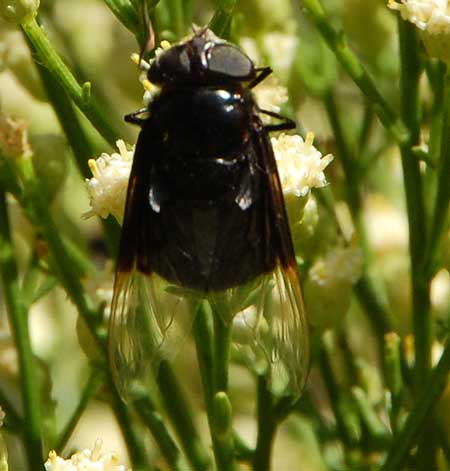Mexican Cactus Fly
Copestylum mexicanum

This Cactus Fly was among the menagerie of butterflies, bees, wasps and flies taking nectar at Desert Broom (Baccharis sarothroides) along Rackensack Wash in n.e. Maricopa Co., Arizona, Oct. 2009.
Syrphidae -- Hover Fly Family
To survive hard times, when water is scarce and thus photosynthesis difficult, succulents like cacti store up reserves of carbohydrate, proteins, lipids and water for later use. When a succulent cactus dies this larder of food is suddenly available to the desert community. In other words, after death, a cactus often becomes a seething mass of insects and other creatures taking part in the offering. Among those is a large rat-tailed maggot that will later emerge as a flower-loving, hover fly. The Cactus Fly adult, Copestylum mexicanum, is large and robust, yet is harmless to people as their only interest is taking nectar, mating and finding the next cactus rot. The wings are distinctively marked half clear and half black. The flowers of Seep Baccharis (Baccharis salicifolia) and Desert Broom (Baccharis sarothroides) are among the favored blooms for adult cactus flies to visit. The next cactus rot could be many kilometers away - the nectar serves as flight fuel for the adult cactus fly.
The inside of a rotting cactus frequently becomes liquefied and insects which live in this soup are aquatic adapted. Rat-tailed maggots for example have an elongated abdomen (tail) supporting air-intake spiracles at the tip. When the worm-like maggot-larva needs oxygen it raises its spiracles up out of the soup and into the air.